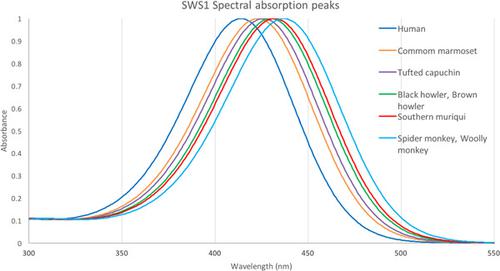当前位置:
X-MOL 学术
›
Am. J. Primatol.
›
论文详情
Our official English website, www.x-mol.net, welcomes your
feedback! (Note: you will need to create a separate account there.)
Genetic variability of the sws1 cone opsin gene among New World monkeys
American Journal of Primatology ( IF 2.0 ) Pub Date : 2020-09-29 , DOI: 10.1002/ajp.23199 Viviani Mantovani 1 , Einat Hauzman 1, 2 , Vitor H. Corredor 1 , Paulo R. K. Goulart 3 , Olavo Galvão 3 , Mauricio Talebi 4 , Daniel M. A. Pessoa 5 , Juliana G. M. Soares 6 , Mario Fiorani 6 , Ricardo Gattass 6 , Dora Ventura Fix 1, 2 , Daniela M. O. Bonci 1, 2
American Journal of Primatology ( IF 2.0 ) Pub Date : 2020-09-29 , DOI: 10.1002/ajp.23199 Viviani Mantovani 1 , Einat Hauzman 1, 2 , Vitor H. Corredor 1 , Paulo R. K. Goulart 3 , Olavo Galvão 3 , Mauricio Talebi 4 , Daniel M. A. Pessoa 5 , Juliana G. M. Soares 6 , Mario Fiorani 6 , Ricardo Gattass 6 , Dora Ventura Fix 1, 2 , Daniela M. O. Bonci 1, 2
Affiliation

|
Vision is a major sense for Primates and the ability to perceive colors has great importance for the species ecology and behavior. Visual processing begins with the activation of the visual opsins in the retina, and the spectral absorption peaks are highly variable among species. In most Primates, LWS/MWS opsins are responsible for sensitivity to long/middle wavelengths within the visible light spectrum, and SWS1 opsins provide sensitivity to short wavelengths, in the violet region of the spectrum. In this study, we aimed to investigate the genetic variation on the sws1 opsin gene of New World monkeys (NWM) and search for amino acid substitutions that might be associated with the different color vision phenotypes described for a few species. We sequenced the exon 1 of the sws1 opsin gene of seven species from the families Callitrichidae, Cebidae, and Atelidae, and searched for variation at the spectral tuning sites 46, 49, 52, 86, 90, 93, 114, 116, and 118. Among the known spectral tuning sites, only residue 114 was variable. To investigate whether other residues have a functional role in the SWS1 absorption peak, we performed computational modeling of wild‐type SWS1 and mutants A50I and A50V, found naturally among the species investigated. Although in silico analysis did not show any visible effect caused by these substitutions, it is possible that interactions of residue 50 with other sites might have some effect in the spectral shifts in the order of ~14 nm, found among the NWM. We also performed phylogenetic reconstruction of the sws1 gene, which partially recovered the species phylogeny. Further studies will be important to uncover the mutations responsible for the phenotypic variability of the SWS1 of NWM, and how spectral tuning may be associated with specific ecological features such as preferred food items and habitat use.
中文翻译:

新世界猴中sws1视锥蛋白基因的遗传变异
视觉是灵长类动物的主要感觉,感知颜色的能力对于物种的生态和行为非常重要。视觉处理始于视网膜中视觉视蛋白的激活,并且光谱吸收峰在物种之间高度可变。在大多数灵长类动物中,LWS / MWS视蛋白负责对可见光谱内长/中波长的敏感度,而SWS1视蛋白则对光谱的紫色区域内的短波长敏感。在这项研究中,我们旨在调查新世界猴子(NWM)的sws1 opsin基因的遗传变异,并寻找可能与少数物种描述的不同色觉表型有关的氨基酸取代。我们对sws1的外显子1进行了测序来自Callitrichidae,Cebidae和Atelidae科的七个物种的视蛋白基因,并在光谱调谐位点46、49、52、86、90、93、114、116和118处寻找变异。在已知的光谱调谐位点中,只有残基114是可变的。为了研究其他残基在SWS1吸收峰中是否具有功能性作用,我们对野生型SWS1以及在所调查物种中自然发现的突变体A50I和A50V进行了计算建模。尽管计算机分析未显示出由这些取代引起的任何可见效应,但仍有可能残基50与其他位点的相互作用对〜14 nm数量级的光谱位移产生一定的影响,这是在NWM中发现的。我们还对sws1进行了系统发育重建基因,部分恢复了物种的系统发育。进一步的研究对于揭示导致NWM SWS1表型变异的突变,以及如何将光谱调节与特定的生态特征(例如首选的食物和栖息地的使用)相关联至关重要。
更新日期:2020-11-19
中文翻译:

新世界猴中sws1视锥蛋白基因的遗传变异
视觉是灵长类动物的主要感觉,感知颜色的能力对于物种的生态和行为非常重要。视觉处理始于视网膜中视觉视蛋白的激活,并且光谱吸收峰在物种之间高度可变。在大多数灵长类动物中,LWS / MWS视蛋白负责对可见光谱内长/中波长的敏感度,而SWS1视蛋白则对光谱的紫色区域内的短波长敏感。在这项研究中,我们旨在调查新世界猴子(NWM)的sws1 opsin基因的遗传变异,并寻找可能与少数物种描述的不同色觉表型有关的氨基酸取代。我们对sws1的外显子1进行了测序来自Callitrichidae,Cebidae和Atelidae科的七个物种的视蛋白基因,并在光谱调谐位点46、49、52、86、90、93、114、116和118处寻找变异。在已知的光谱调谐位点中,只有残基114是可变的。为了研究其他残基在SWS1吸收峰中是否具有功能性作用,我们对野生型SWS1以及在所调查物种中自然发现的突变体A50I和A50V进行了计算建模。尽管计算机分析未显示出由这些取代引起的任何可见效应,但仍有可能残基50与其他位点的相互作用对〜14 nm数量级的光谱位移产生一定的影响,这是在NWM中发现的。我们还对sws1进行了系统发育重建基因,部分恢复了物种的系统发育。进一步的研究对于揭示导致NWM SWS1表型变异的突变,以及如何将光谱调节与特定的生态特征(例如首选的食物和栖息地的使用)相关联至关重要。











































 京公网安备 11010802027423号
京公网安备 11010802027423号